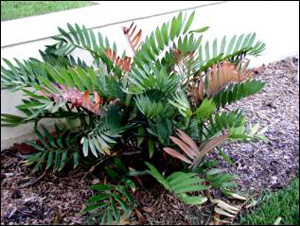Cardboard Plant

Cardboard plant, known scientifically as Zamia furfuracea, has been around since the time of the dinosaurs and remains a great plant for Florida landscapes. It provides a year-round display of striking foliage and, once established, requires little water or maintenance, helping explain why it was named a 2007 Florida Plant of the Year by the Florida Nursery Growers & Landscape Association (FNGLA).
Mistaken Identity
Although many people refer to cardboard plant as “cardboard palm,” it isn’t a true palm. Instead, it’s what is botanically known as a cycad. Cycads and palms share similar leaf structures, but are actually two unique types of plants. Other cycads include the native coontie, or Zamia pumila, and the widely used king sago, Cycas revoluta.
Plant Characteristics
The fronds of cardboard plant can grow to 3 feet long with up to twelve pairs of stiff, leathery, dark green leaflets. The foliage is evergreen and provides a great backdrop for colorful flowers in landscape beds.
If you want to use cardboard plant in your landscape, be sure to select a site that will leave the plant ample room to grow. Cardboard plants are slow growing, but can reach up to 6 feet in diameter.
The leaves grow out of a thick, fleshy trunk that serves as a reservoir in times of drought. The trunk is also where the unique looking reproductive structures arise. Male plants and female plants each produce their own cones. After the female cones are fertilized, they ripen and break open to reveal a number of tightly packed, bright red seeds.
Growth Conditions
Native to Mexico, cardboard plant is hardy in USDA hardiness zones 9-11, which means it is best suited for central and south Florida. Growing in full sun or shade, cardboard plant tolerates a variety of well-drained soils.
For more information on the cardboard plant, contact your county Extension office.
